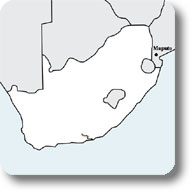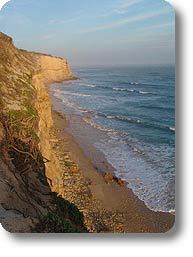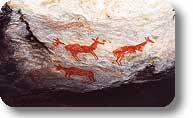
 |
Addo Elephant National Park |
Protected Area |
||||
 |
|
|||
Welcome to Addo Elephant National Park |
||||
 |
Deep within the shadows of the dense valley bushveld of the Sundays River region of the Eastern Cape lies the Addo Elephant National Park. Here, the evenings are punctuated by the strident howl of the black-backed jackal, and the francolin's call heralds each new dawn. Safe from relentless persecution in the past, the grey leviathans of the bush now roam in peace. The original Elephant section of the park was proclaimed in 1931, when only eleven elephants remained in the area - today this finely tuned ecosystem is sanctuary to over 420 elephants, 450 Cape buffalo, black rhino, a variety of antelope species, as well as the unique flightless dung beetle, found almost exclusively in Addo. For the first time in over 100 years, lion and spotted hyena were reintroduced to the park last year. But the Addo story has only just begun. Plans to expand the 148,000 hectare Addo National Elephant Park into a 360,000 hectare "Greater Addo" park are moving forward at an exciting pace. This expansion is transforming Addo into the ultimate tourism destination. Some of its unique features include:
The Addo Elephant National Park is one of 20 national parks run by South Africa National Parks (SANParks). |
|||
History |
||||
| In the early centuries, when great herds of wild animals roamed the Addo region, the Khoisan of the Iqua, Damasqua and Gonaqua clans lived in the area. They hunted and kept cattle but tragically were largely wiped out in the 1700s by the smallpox epidemic. Nomadic Xhosa tribes had kraals in the area, including Chief Cungwa of the Gqunukhwebe (near the Sundays River mouth and inland) and Chief Habana of the Dange (near the Wit River).
The Addo Elephant National Park (AENP) was proclaimed in 1931 to protect the remaining 11 Addo elephants. The great herds of elephants and other animal species had been all but decimated over the 1700s and 1800s by hunters. In the late 1800s, farmers began to colonise the area around the park, also taking their toll on the elephant population due to competition for water and crops. >>>
|
||||
Climate |
||||
|
||||
Fauna |
||||
| This park offers some of the most spectacular elephant viewing in the world. Addo's over 400 elephants will delight visitors with their antics. The park contributes to the conservation of the endangered black rhino with over 40 of these animals occurring here. The over 450 Cape buffalo are now being seen more often during the day due to the influence of lion reintroduction. This is one of the largest disease-free herds in South Africa. Six lions were introduced into the park in late 2003 and have adapted well to their new environment. Lions are most often seen in the early morning or on sunset and night drives. Spotted hyenas were also reintroduced last year, fulfilling the same role as lions in restoring the natural balance to the ecosystems in the park by controlling the numbers of herbivores. Leopard are very seldom seen, being shy and secretive animals, but do occur in most areas of the expanded park. >>>
|
||||
|
Some images of the Wildlife living in the Park |
||||
|
||||
Flora |
||||
| Addo's vegetation is remarkable because in a relatively small area, five of South Africa's habitat biomes are found. (Much larger parks such as Kruger National have only one biome). The original Addo-Elephant area is in succulent valley thicket, characterized by impenetrable spekboom. It was this vegetation that protected the last remaining elephant and buffalo from being wiped out by hunters. The Zuurberg Mountains harbour deep wooded kloofs and streams. In the exposed higher altitude areas, grassland and fynbos are found. Moving inland over the mountains the area around Darlington Lake turns to succulent Karoo-type (arid semi-desert) vegetation known as noorsveld. On the seaward side of the original elephant section the Woody Cape section contains a remarkable display of coastal dune-fields and coastal grassy plains. Moving east the Alexandria Forest is an excellent example of pristine temperate forest. |
||||
 |
Cultural Heritage |
|||
| As in many of South Africa's national parks, the AENP encompasses a rich natural and cultural heritage. One of the challenges of the future is to ensure effective management of these cultural resources including the access of all interested parties. A preliminary study by the Albany Museum mapped archeological, paleontological, cultural and historical sites within the park. Future plans include a more detailed mapping process as well as the development of an access management plan. |